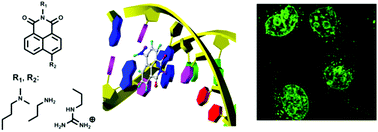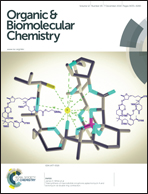Effects of side chains on DNA binding, cell permeability, nuclear localization and cytotoxicity of 4-aminonaphthalimides†
Abstract
Nucleic acid binding molecules have been extensively explored for nucleic acid assay, nuclear imaging, and antitumor and antivirus therapies. Most of these molecules usually bear positive charges to enhance their binding affinity. However, their in vivo applications are limited by poor membrane permeability and the lack of selectivity to nucleic acids. Here we describe the effects of positive charged side chains (including aminoethyl, dimethylaminopropyl and guanidinoethyl) on the DNA binding ability, cell permeability, cellular localization and cytotoxicity of 4-aminonaphthalimides, a class of DNA-intercalating agents and fluorophores. The synthesized 4-aminonaphthalimides have a strong binding ability to duplex DNA, and can be used as pre-staining dyes for gel electrophoresis of DNA and RNA. When entering into cells, they rapidly concentrate in cell nuclei, especially in nucleoli. The guanidinoethyl side chains increase the binding ability to nucleic acids, but do not favour the cell permeability and cytotoxicity; dimethylaminopropyl groups enhance the cell permeability and cytotoxicity of 4-aminonaphthalimides. These results suggest the potential applications of 4-aminonaphthalimides in nucleic acid assay and nuclear imaging, and provide useful information for the molecular design of DNA-binding drugs and fluorescent probes.


 Please wait while we load your content...
Please wait while we load your content...